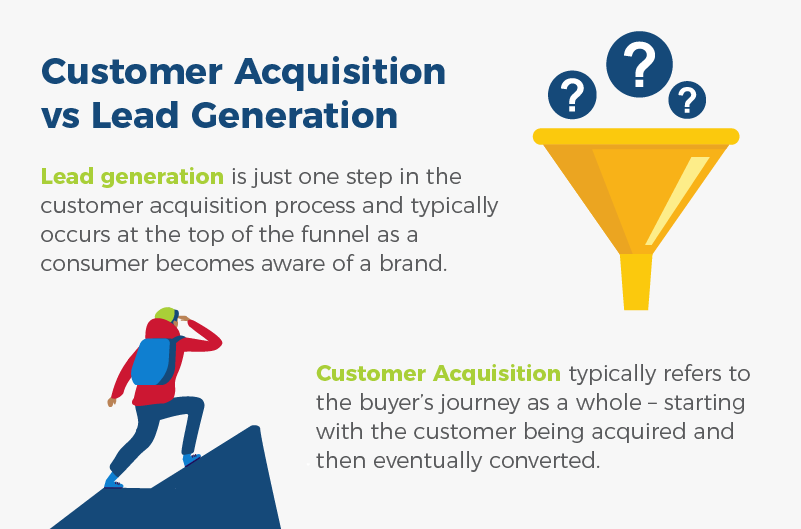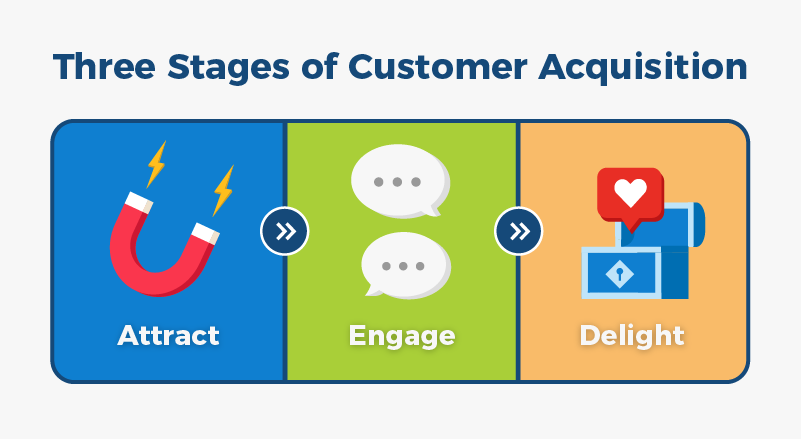Customer Acquisition
Your Flywheel to Business Growth
Customer Acquisition: Stages, Strategies, and Tools for Business Growth
Let’s face it, growing a business is a ton of fun, but it’s also tough. From acquiring new customers to delighting your current ones, it seems like a constantly moving target. You may find yourself wrestling with questions like…
- Do I have the right strategy in place?
- What tactics have the best ROI?
- Is our company customer-centric?
- What processes are hindering growth?
- How do I make sure I’m not just growing the company but scaling profitably?
The good news is there are direct, concrete answers to these questions – and we’re going to share them with you. The first place to start is customer acquisition.
It seems like a no-brainer, right? Start growing your business by getting more customers. But how do you actually build a customer acquisition strategy? Keep reading to better understand what it takes and the process you should follow to help your business scale profitably. Fair warning, it won’t be easy and it will take time…but we have a feeling if you found this guide, you’re more excited than intimidated. Let’s get started!
Table of Contents
- Introduction to Customer Acquisition
- The Customer Acquisition Process
- Effective Strategies for Customer Acquisition
- Improving Your Customer Acquisition Strategy
- Calculating Customer Acquisition Cost (CAC)
- Customer Acquisition in CRM: Building Customer Relationships for Long-Term Retention
Introduction to Customer Acquisition
Customer acquisition is simply the process of attracting new customers to your business. Your main objective here is to create an efficient and sustainable acquisition strategy that can adapt to shifts and trends.
Having a customer acquisition strategy is essential if you want to keep your sales pipeline full. This consistent stream of revenue allows you to 1) cover the costs to operate your business, 2) invest in fresh initiatives to scale your business to new heights, and 3) show evidence of business growth to investors and partners.
Customer Acquisition vs Lead Generation
The customer journey is most often illustrated as a funnel that details the different stages in the buying process. These stages also relate to the mindset of the consumer as they move through the funnel.

The stages of the buyer’s journey can help us understand the difference between customer acquisition and lead generation. These stages include:
- Awareness – the consumer becomes aware of your brand
- Consideration – the consumer compares your brand to other brands/options
- Decision – the consumer makes the decision to become a paying customer or client
Lead generation typically occurs at the top of the funnel as a consumer becomes aware of a brand. Lead acquisition happens in the middle of the funnel as a consumer is added to your CRM and begins navigating the sales process. Conversion is when the lead reaches the decision stage and finally converts into a customer.
With that in mind, customer acquisition typically refers to the buyer’s journey as a whole – starting with the customer being acquired and then eventually converted. Lead generation is just one step in the customer acquisition process.
The Customer Acquisition Process
Above we mentioned the three stages of the buyer’s journey, but many modern businesses are transforming the typical funnel into a flywheel model based on the stages of: Attract, Engage, and Delight.

This is an expansion of the original funnel in that 1) it takes on the perspective of a potential customer and 2) it makes use of your marketing, sales, and service teams.
Once you understand these stages, you’ll have a better idea of how your prospective customer base thinks and how you can use acquisition marketing to spin the flywheel.
Stage 1: Attract
Much like the Awareness stage of the buyer’s journey, the Attract stage here refers to the moment when consumers become exposed to a brand. This might happen as a result of content marketing efforts, search engine optimization, social media engagement, search engine marketing, targeted ads, word of mouth, and much more.
When it comes to creating your customer acquisition flywheel, your goal here should be to launch marketing campaigns that appeal to potential customers and reach them where they are at. This is where inbound marketing most often comes into play.
Stage 2: Engage
Once you’ve caught the attention of your ideal customer, you now need them to take action. This might start off as downloading an ebook or signing up for an email list. Then, if you have marketed your products or services effectively, consumers will take action and become paying customers.
This is where consumers expect an easy, hassle-free buying process, so it’s important that brands make this as frictionless as possible. You’ll want to educate your sales team on how to maximize performance, up-sell and cross-sell for more sales, and handle any objections customers have during this stage.
Stage 3: Delight
New customers may reach out to your support team with questions or concerns after making their purchase. How helpful and responsive your team is will play a role in customer delight, which affects retention and repeat business. This step is mastered by brands that are able to create helpful customer service content that customers can access when they need it.
Happy customers easily turn into brand ambassadors who can promote your brand to other people. These customers can help increase brand recognition and send new customers your way. You can encourage advocacy by giving customers multiple opportunities to share your content, publish testimonials, and interact with your business online.
Effective Strategies for Customer Acquisition
New customer acquisition is much easier when you have the right customer acquisition methods in place. Your organization is probably even using many of these channels already. Now let’s just fine-tune your process to use them more effectively.
Here are the most common customer acquisition strategies and how we recommend using them to grow your business.
Content Marketing: Attracting Customers with Value-Driven Content
Content marketing involves sharing high-value content across multiple channels in order to attract customers online. By publishing blog posts, social media posts, videos, and other types of engaging content, you can catch consumers at the attract stage.
Leveraging Social Media for Customer Engagement
Customer acquisition through social media marketing is highly effective because of how easy it is to talk directly to your target audience on these platforms. Platforms like Facebook, Instagram, Twitter, Pinterest, and LinkedIn can be great places to acquire new customers. Plus, you can use social media to provide top-quality customer service and encourage existing customers to be advocates who help share your message.
Email Marketing to Reach a Mass Audience
Statistics show that the success rate of selling to an existing customer is 60-70%, while the success rate of selling to a new customer is closer to 5-20%. Brands can use email marketing to re-engage existing customers, promote new offers and deals, and improve customer service.
You can also use email marketing to warm up a lead who might not be ready to convert just yet. Set up an automated series to keep your brand top of mind and easily increase your conversion rates.
Pay-Per-Click Advertising: Paid Advertising and Its Impact on Acquisition
Pay-per-click (PPC) advertising involves paying a set cost-per-click for ads to be shown to your target audience. For example, Google Ads can reach consumers who are using the search engine to find solutions just like the products or services you offer. Paid advertising can be a great way to get noticed where consumers are actively looking.
Organic Search Marketing: The Role of SEO in Customer Acquisition
Similarly, brands can use search engine optimization (SEO) to get their websites ranked high in the organic search results. If a consumer searches for a product, service, or topic, and your site is well-optimized, SEO can drive traffic to your website. This traffic can then turn into leads and new customers.
Improving Your Customer Acquisition Strategy
Want to learn how to increase customer acquisition? Then you’ll need to fine-tune your existing acquisition marketing efforts and implement a system that consistently attracts new customers.
Ready to get started?
Establish Your Foundation
First, you need to strengthen your foundation by establishing brand standards from the beginning and creating a content style guide that outlines your brand’s voice and how you create content.
Create Audience-Focused Content
Your next step is conducting market research to better understand your audience and create content that’s most relevant to them. This content will be shared across a variety of platforms to send traffic back to your website and capture leads for your business.
Focus on Customer Retention
Finally, you’ll want to provide the best service possible to your customers so they enjoy working with you and will refer new business to you. If you’re gaining customers through free word of mouth, you become even less dependent on outreach and outbound marketing.

Calculating Customer Acquisition Cost (CAC)
How much customer acquisition costs will vary depending on your unique business. Customers for big-ticket items like cars or specialized services like IT security will take longer and cost more to convert than someone looking for a product like a new pair of sneakers which is much easier to convert and more cost-effective. Of course, it’s important to understand your customer acquisition costs in order to make the most of your marketing spend.
You also need to understand how much that customer is worth to your business. For example, a customer who signs up for IT security services is going to bring in a higher dollar amount on a consistent basis than someone who buys a pair of new sneakers every few years.
Having a clear picture of both your customer acquisition costs and your customer lifetime value will paint a clear picture of what it will cost you to scale and grow your company.
Customer Acquisition in CRM: Building Customer Relationships for Long-Term Retention
Customer acquisition does require both time and planning to yield the best results. But with the help of a customer relationship management (CRM) system, you can streamline the customer acquisition process, improve efficiency, and provide that top-quality service your customers deserve.
Tools like Hubspot CRM make customer acquisition simple and affordable – two things business owners love. Here’s what you need to do to manage customer acquisition in CRM:
Understanding Customer Behavior Through Data
Use CRM software to create a database of your current customers, record key information such as birthdays and anniversaries, determine your ideal customer, create customer personas, and keep all the contact information for incoming leads organized and accessible.
Track Your Data (and your wins)
Your CRM tool will help you create detailed marketing reports, manage contact information, track progress in your customers’ buying journeys, view overall customer growth, and more to see how your customer acquisition efforts are paying off.
Utilize Hubspot CRM
Hubspot provides a wealth of information regarding the methodology behind a CRM tool, the connection between sales and marketing departments, how to implement website and online integrations, how to access their database, and more.
Striventa Helps Businesses Grow Through Customer Acquisition
If you’re struggling to attract more of the right type of customers to your business, then your customer acquisition strategy might be in need of an overhaul. The good news is that there are tons of resources to help you turn your business into a lead- and customer-generating machine.
Our marketing team gives you real, long-term results. Reach out today so we can learn more about your business goals and how we can help you achieve them.
Back to Top